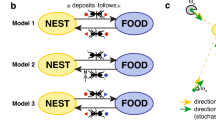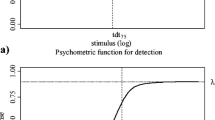Abstract
We propose an Individual-Based Model of ant-trail formation. The ants are modeled as self-propelled particles which deposit directed pheromone particles and interact with them through alignment interaction. The directed pheromone particles intend to model pieces of trails, while the alignment interaction translates the tendency for an ant to follow a trail when it meets it. Thanks to adequate quantitative descriptors of the trail patterns, the existence of a phase transition as the ant–pheromone interaction frequency is increased can be evidenced. We propose both kinetic and fluid descriptions of this model and analyze the capabilities of the fluid model to develop trail patterns. We observe that the development of patterns by fluid models require extra trail amplification mechanisms that are not needed at the Individual-Based Model level.
Similar content being viewed by others
References
Aoki I (1982) A simulation study on the schooling mechanism in fish. Bull Japan Soc Sci Fish 48: 1081–1088
Beckers R, Deneubourg JL, Goss S (1992) Trail laying behaviour during food recruitment in the ant Lasius niger (L). Insectes Sociaux 39: 59–72
Beckers R, Deneubourg JL, Goss S, Pasteels JM (1990) Collective decision making through food recruitment. Insectes Sociaux 37: 258–267
Bernadou A, Fourcassié V (2008) Does substrate coarseness matter for foraging ants? an experiment with Lasius niger (Hymenoptera; formicidae). J Insect Physiol 54: 534–542
Blanchet A, Dolbeault J, Perthame B (2006) Two-dimensional Keller–Segel model: optimal critical mass and qualitative properties of the solutions. Electron J Differ Equ 44: 1–33
Boissard E, Degond P (2012, in preparation)
Bossert WH, Wilson EO (1963) The analysis of olfactory communication among animals. J Theor Biol 5: 443–469
Calenbuhr V, Deneubourg JL (1992) A model for osmotropotactic orientation (I)*. J Theor Biol 158: 359–393
Calenbuhr V, Chretien L, Deneubourg JL, Detrain C (1992) A model for osmotropotactic orientation (II)*. J Theor Biol 158: 395–407
Calvez V, Carrillo JA (2006) Volume effects in the Keller–Segel model: energy estimates preventing blow-up. Journal de Mathématiques Pures et Appliquées 86: 155–175
Casellas E, Gautrais J, Fournier R, Blanco S, Combe M, Fourcassié V, Theraulaz G, Jost C (2008) From individual to collective displacements in heterogeneous environments. J Theor Biol 250: 424–434
Cercignani C, Illner R, Pulvirenti M (1994) The mathematical theory of dilute gases. Springer, Berlin
Chaté H, Ginelli F, Montagne R (2006) Simple model for active nematics: quasi-long-range order and giant fluctuations. Phys Rev Lett 96: 180602
Couzin ID, Franks NR (2003) Self-organized lane formation and optimized traffic flow in army ants. Proc Roy Soc B Biol Sci 270: 139–146
Deneubourg JL, Aron S, Goss S, Pasteels JM (1990) The self-organizing exploratory pattern of the argentine ant. J Insect Behav 3: 159–168
Detrain C, Natan C, Deneubourg JL (2001) The influence of the physical environment on the self-organized foraging patterns of ants. Naturwissenschaften 88: 171–174
Edelstein-Keshet L (1994) Simple models for trail-following behaviour; trunk trails versus individual foragers. J Math Biol 32: 303–328
Edelstein-Keshet L, Watmough J, Ermentrout GB (1995) Trail following in ants: individual properties determine population behaviour. Behav Ecol Sociobiol 36: 119–133
Erban R, Othmer HG (2004) From individual to collective behavior in bacterial chemotaxis. SIAM J Appl Math 70: 361–391
Ermentrout GB, Edelstein-Keshet L (1993) Cellular automata approaches to biological modeling. J Theor Biol 160: 97–133
Filbet F, Laurençot P, Perthame B (2005) Derivation of hyperbolic models for chemosensitive movement. J Math Biol 50: 189–207
Goss S, Aron S, Deneubourg JL, Pasteels JM (1989) Self-organized shortcuts in the argentine ant. Naturwissenschaften 76: 579–581
Grassé PP (1986) Termitologia: comportement, socialité, écologie, évolution, systématique. Masson, France
Grünbaum D (2006) Align in the sand. Science 312: 1320–1322
Haefner JW, Crist TO (1994) Spatial model of movement and foraging in harverster ants (Pogonomyrmes) (I): the roles of memory and communication. J Theor Biol 166: 299–313
Hangartner W (1969) Trail laying in the subterranean ant, Acanthomyops interjectus. J Insect Physiol 15: 1–4
Hillen T, Othmer HG (2000) The diffusion limit of transport equations derived from velocity-jump processes. SIAM J Appl Math 61: 751–775
Jackson DE, Châline N (2007) Modulation of pheromone trail strength with food quality in Pharaoh’s ant, Monomorium pharaonis. Animal Behav 74: 463–470
Jeanson R, Deneubourg J-L, Grimal A, Theraulaz G (2004) Modulation of individual behavior and collective decision-making during aggregation site selection by the ant Messior barbarus. Behav Ecol Sociobiol 55: 388–394
John A, Schadschneider A, Chowdhury D, Nishinari K (2004) Collective effects in traffic on bi-directional ant trails. J Theor Biol 231: 279–285
Katz Y, Tunstrom K, Ioannou CC, Huepe C, Couzin ID (2011) Inferring the structure and dynamics of interactions in schooling fish. Proc Natl Acad Sci 108: 18720–18725
Keller EF, Segel LA (1971) Model for chemotaxis. J Theor Biol 30: 225–234
Lukeman R, Li Y-X, Edelstein-Keshet L (2010) Inferring individual rules from collective behavior. Proc Natl Acad Sci 107: 12576–12580
Morgan ED (2009) Trail pheromones of ants. Physiol Entomol 34: 1–17
Nishinari K, Sugawara K, Kazama T, Schadschneider A, Chowdhury D (2006) Modelling of self-driven particles: Foraging ants and pedestrians. Phys A Stat Mech Appl 372: 132–141
Othmer HG, Hillen T (2002) The diffusion limit of transport equations II: chemotaxis equations. SIAM J Appl Math 62: 1222–1250
Othmer HG, Stevens A (1997) Aggregation, blowup, and collapse: the ABC’s of taxis in reinforced random walks. SIAM J Appl Math 57: 1044–1081
Painter KJ (2009) Modelling cell migration strategies in the extracellular matrix. J Math Biol 58: 511–543
Peters K, Johansson A, Dussutour A, Helbing D (2006) Analytical and numerical investigation of ant behavior under crowded conditions. Adv Complex Syst 9: 337–352
Rauch EM, Millonas MM, Chialvo DR (1995) Pattern formation and functionality in swarm models. Phys Lett A 207: 185–193
Schweitzer F, Lao K, Family F (1997) Active random walkers simulate trunk trail formation by ants. Biosystems 41: 153–166
Stevens A (2000) The derivation of chemotaxis equations as limit dynamics of moderately interacting stochastic many-particle systems. SIAM J Appl Math 61: 183–212
Sutton OG (1953) Micrometeorology. McGraw Hill, New York
Tao T, Nakagawa H, Yamasaki M, Nishimori H (2004) Flexible foraging of ants under unsteadily varying environment. J Phys Soc Japan 73: 2333–2341
Vicsek T, Czirók A, Ben-Jacob E, Cohen I, Shochet O (1995) Novel type of phase transition in a system of self-driven particles. Phys Rev Lett 75: 1226–1229
Vincent AD, Myerscough MR (2004) The effect of a non-uniform turning kernel on ant trail morphology. J Math Biol 49: 391–432
Watmough J, Edelstein-Keshet L (1995) A one dimensional model of trail propagation by army ants. J Math Biol 33: 459–476
Watmough J, Edelstein-Keshet L (1995) Modelling the formation of trail networks by foraging ants. J Theor Biol 176: 357–371
Wilson EO (1962) Chemical communication among workers of the fire ant Solenopsis saevissima (Fr. Smith) 1. the organization of mass-foraging. Animal Behav 10: 134–147
Witte V, Maschwitz U (2002) Coordination of raiding and emigration in the ponerine army ant Leptogenys distinguenda (Hymenoptera: Formicidae: Ponerinae). J Insect Behav 15: 195–217
Author information
Authors and Affiliations
Corresponding author
Rights and permissions
About this article
Cite this article
Boissard, E., Degond, P. & Motsch, S. Trail formation based on directed pheromone deposition. J. Math. Biol. 66, 1267–1301 (2013). https://doi.org/10.1007/s00285-012-0529-6
Received:
Revised:
Published:
Issue Date:
DOI: https://doi.org/10.1007/s00285-012-0529-6
Keywords
- Self-propelled particles
- Pheromone deposition
- Directed pheromones
- Alignment interaction
- Individual-Based Model
- Trail detection
- Pattern formation
- Kinetic models
- Fluid models




